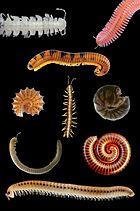| Stemmiulidae | |
|---|---|

| |
| Stemmiulus beroni, a West African species | |
| Scientific classification | |
| Kingdom: | Animalia |
| Phylum: | Arthropoda |
| Subphylum: | Myriapoda |
| Class: | Diplopoda |
| Subclass: | Chilognatha |
| Infraclass: | Helminthomorpha |
| Superorder: | Nematophora |
| Order: | Stemmiulida Cook, 1895 |
| Family: | Stemmiulidae Pocock, 1894 |

Stemmiulida is an order of millipedes consisting of approximately 130 species, reaching up to 50 mm in length. It contains a single family, Stemmiulidae.
Description
Stemmiulids are small to medium sized millipedes, reaching a maximum length of 50 mm (2 in). The body tapers gradually, and is laterally compressed, so is taller than wide. A dorsal groove is present and runs from head to tail. The eyes consist of two large ocelli on each side of the head, and some members are capable of jumping. The living species lack Tömösváry organs, although a fossil species from the Miocene epoch possesses them.
Classification
Stemmiluda contains 6-10 living genera and at least one fossil genus, all in the family Stemmiulidae. Species estimates range from about 120 to 150 species. The taxonomy is controversial, with some authors lumping species into as few as three genera. The most liberal classification is presented below.
- Diopsiulus
- Eostemmiulus
- Nethoiulus
- Paurochaeturus
- †Parastemmiulus (Early-Middle Miocene; Mexican amber)
- Plusiochaeturus
- Prostemmiulus
- Scoliogmus
- Stemmatoiulus
- Stemmijulus
- Stemmiulus
References
- "Diagnostic features of Millipede Orders" (PDF). Milli-PEET Identification Tables. The Field Museum, Chicago. Retrieved 5 April 2014.
- "Putative apomorphies of millipede clades" (PDF). Milli-PEET: Millipede Systematics. The Field Museum, Chicago, IL. 26 September 2006.
- ^ Riquelme, F.; Alvarado-Ortega, J.; Ramos-Arias, M.; Hernández, M.; Dez, I.; Lee-Whiting, T. A.; Ruvalcaba-Sil, J. L. (2013). "A fossil stemmiulid millipede (Diplopoda: Stemmiulida) from the Miocene amber of Simojovel, Chiapas, México". Historical Biology. 26 (4): 1–13. doi:10.1080/08912963.2013.778843. S2CID 85299484.
- Sierwald, Petra; Bond, Jason E. (2007). "Current Status of the Myriapod Class Diplopoda (Millipedes): Taxonomic Diversity and Phylogeny". Annual Review of Entomology. 52 (1): 401–420. doi:10.1146/annurev.ento.52.111805.090210. PMID 17163800.
- ^ Shear, W. (2011). "Class Diplopoda de Blainville in Gervais, 1844. In: Zhang, Z.-Q. (Ed.) Animal biodiversity: An outline of higher-level classification and survey of taxonomic richness" (PDF). Zootaxa. 3148: 159–164. doi:10.11646/zootaxa.3148.1.32.
- Sierwald, Petra, ed. (2006). "Nomenclator Generum Diplopodorum, Version 2. A complete listing of all genus-group names in the class Diplopoda from 1758 through 1999". Field Museum of Natural History. Retrieved 4 April 2014.
- Mauriès, J. P.; Golovatch, S. I.; Geoffroy, J. J. (2010). "Un nouveau genre et une nouvelle espèce de l ordre Stemmiulida du Viet-Nam (Diplopoda) [A new genus and species of the order Stemmiulida from Vietnam]". Arthropoda Selecta. 19 (2): 73–80. doi:10.15298/arthsel.19.2.03.
| Orders of the class Diplopoda (millipedes) | |||||||||||||||||||||||||||||||||
|---|---|---|---|---|---|---|---|---|---|---|---|---|---|---|---|---|---|---|---|---|---|---|---|---|---|---|---|---|---|---|---|---|---|
| |||||||||||||||||||||||||||||||||
| |||||||||||||||||||||||||||||||||
| |||||||||||||||||||||||||||||||||
| Taxon identifiers | |
|---|---|
| Stemmiulidae | |

